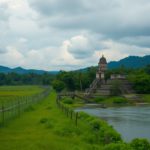Essential Proactive Measures to Prepare for Earthquake Aftershocks: A Comprehensive Resource
In the aftermath of an earthquake, the ground may continue to tremble due to aftershocks, which can pose serious threats to both personal safety and the structural integrity of buildings. Adequate preparation for these subsequent seismic events is crucial, as effective earthquake aftershock preparation can significantly reduce the associated risks. By adopting a proactive and well-informed strategy, individuals and families can enhance their ability to protect themselves and their belongings from the dangers posed by aftershocks.
Recognising the Importance of Immediate Actions Following an Earthquake

The initial moments after the first tremor are of utmost importance. Taking immediate action can significantly reduce the risks associated with aftershocks, which frequently happen within days or even weeks following the main earthquake. Understanding that these aftershocks can inflict damage comparable to the original quake is critical for effective readiness. A household that is well-prepared is capable of responding swiftly, thus safeguarding the health and safety of its members.
Once the earthquake has occurred, it is imperative to remain vigilant and reassess your environment. Identify any potential hazards, such as fallen objects, gas leaks, or compromised structural components. By taking prompt and decisive action, you can improve your safety and that of those around you, thereby laying the groundwork for a thorough earthquake aftershock preparation plan.
Key Items to Include in Your Emergency Kit for Aftershocks
A carefully curated emergency kit is essential for successful earthquake aftershock preparation. Your kit should encompass the following crucial components:
– Water: Stock one gallon per person per day for a minimum of three days.
– Non-perishable food: Ensure you have sufficient food supplies for at least three days, including ready-to-eat meals.
– First Aid Supplies: A well-stocked kit capable of addressing common injuries and health concerns.
– Communication Tools: Battery-operated radios, mobile phones, and their respective chargers are essential for staying connected.
– Flashlights: Include these along with spare batteries to light your surroundings during a power outage.
These supplies should be easily accessible and routinely inspected to ensure they remain functional and within their expiration dates, enhancing your preparedness for any eventualities.
The Importance of Regular Drills and Training for Aftershock Preparedness
Engaging in regular preparedness drills is crucial for effective earthquake aftershock preparation. Involving the entire family in these exercises ensures that every member comprehends the correct actions to take during an aftershock. It is vital to practice essential techniques such as drop, cover, and hold on, alongside simulating evacuation scenarios to reinforce established safety protocols.
Moreover, training should extend beyond the family unit; consider participating in community workshops focused on earthquake readiness. The more familiar you and your neighbours become with emergency procedures, the better equipped you will be to respond efficiently when the ground begins to tremble again.
Establishing Effective Communication Strategies for Aftershocks

Creating clear and reliable communication strategies is essential during aftershocks. Designate a primary contact person who lives outside the immediate area. This individual can facilitate coordination efforts and ensure the safety of family members during times of crisis.
Utilising mobile phones, social media platforms, and local emergency services can significantly enhance communication effectiveness. It is crucial that all family members are proficient in using these tools, including knowing specific meeting points for regrouping in case of separation.
Gaining Insights into Earthquake Aftershock Patterns for Better Preparedness
Understanding the characteristics of aftershocks is vital for effective earthquake aftershock preparation. These tremors can be unpredictable, and recognising their patterns can significantly improve your preparedness efforts.
Investigating the Causes Behind Aftershocks
Aftershocks occur due to the redistribution of stress along fault lines following a significant earthquake. When the Earth’s crust shifts, it establishes a new equilibrium, and the energy released often results in smaller seismic events known as aftershocks. This process can persist for an extended duration, sometimes prolonging for weeks or even months after the initial quake.
Evaluating the Likelihood of Aftershock Events Occurring

While accurately predicting the timing and magnitude of aftershocks remains a complex challenge, scientists employ historical data and seismic activity patterns to assess their likelihood. By analysing previous earthquakes and their subsequent aftershocks, researchers can provide forecasts that assist communities in their preparedness initiatives.
Understanding that aftershocks can occur in clusters is vital for developing effective response strategies. Staying informed through reliable sources will strengthen your earthquake aftershock preparation efforts.
Comprehending the Duration and Frequency of Aftershocks
The duration and frequency of aftershocks can vary significantly. Generally, the most significant aftershocks are likely to take place within days following the primary earthquake; however, smaller tremors might persist for months. This ongoing seismic activity necessitates a continuous state of alertness for residents in affected regions, underscoring the importance of comprehensive preparedness measures.
Assessing the Impact of Aftershocks on Structural Safety
The risk of structural damage from aftershocks is particularly pronounced for buildings that have already experienced damage during the initial earthquake. Continuous shaking can exacerbate existing vulnerabilities, potentially leading to further collapses. This reality highlights the importance of preparing for aftershocks and ensuring that buildings are fortified to withstand seismic forces effectively.
Proven Methods to Fortify Your Home Against Aftershocks
Implementing a robust home preparedness plan is essential for successful earthquake aftershock preparation. Strengthening the resilience of your residence can safeguard your family and property during subsequent seismic events.
Securing Furniture and Appliances to Minimise Potential Risks
One of the most effective strategies for protecting your home is by securing furniture and appliances. Utilise brackets, straps, and wall anchors to prevent items from toppling over during aftershocks. Ensure that large pieces of furniture, such as bookcases, are anchored firmly against walls, and position major appliances away from high-traffic areas where they could pose a risk of injury if they fall.
Enhancing Your Home’s Structural Integrity for Earthquake Resilience
Consider retrofitting your home to improve its capacity to withstand seismic activity. Engaging a qualified contractor to evaluate your home’s structural integrity can help identify weaknesses and recommend necessary enhancements. These may include bolting the foundation, reinforcing walls, or upgrading roofing materials to improve resilience against the forces generated by aftershocks.
Designating Safe Zones Within Your Home for Family Protection
Identify specific areas in your home where family members can safely gather during aftershocks. These safe zones should be located away from windows, heavy furniture, and other potential hazards that could result in injury. Ensure that all household members are familiar with these locations and conduct regular drills to reinforce their significance.
Conducting Regular Inspections for Gas and Water Leak Detection
Routine inspections of utility lines are vital in earthquake aftershock preparation. Aftershocks can potentially rupture gas lines or water pipes, leading to hazardous leaks. Familiarise yourself with the locations of gas shut-off valves and ensure that all family members are trained to turn off utilities quickly and efficiently during an emergency situation.
Assembling Comprehensive Emergency Kits: Vital Supplies for Aftershocks
An adequately stocked emergency kit is essential for thorough earthquake aftershock preparation. Ensuring you have the appropriate supplies can significantly impact your ability to manage the aftermath of an earthquake.
Water and Non-Perishable Food Essentials for Your Emergency Kit
Water and non-perishable food should form the foundation of your emergency supplies. Aim to have at least three days' worth of food and water per person. Opt for non-perishable items such as canned goods, dried fruits, nuts, and granola bars. Don’t forget to include a manual can opener in your kit for convenience.
First Aid Kits and Medications: Essential for Emergency Preparedness
A well-equipped first aid kit is crucial for addressing injuries that may arise during aftershocks. Your kit should encompass bandages, antiseptics, pain relief medications, and any personal prescriptions required by you or your family members. Regularly check and replenish your kit to ensure all items are functional and within their expiration dates.
Tools and Supplies for Prompt Repairs Following an Earthquake
Keep essential tools and materials readily available for quick repairs after an earthquake. Items such as hammers, nails, screwdrivers, and duct tape can be invaluable for addressing minor damages. Additionally, consider including tarps or plastic sheeting to protect your home from the elements until more extensive repairs can be undertaken.
Communication Devices and Backup Power Sources for Emergency Situations
Ensure that communication devices, including battery-operated radios, mobile phones, and chargers, are stored in a readily accessible location. Have extra batteries available for all devices in your emergency kit. Staying informed about aftershocks and other crucial updates is essential for maintaining safety during uncertain times.
Family Safety Strategies to Implement During Aftershocks
Families can adopt proactive measures to enhance their safety during aftershocks. By educating and preparing together, households can effectively navigate the challenges posed by these subsequent tremors.
Teaching Children About Aftershocks and Safety Protocols
It is crucial to educate children about the risks associated with aftershocks. Teach them the appropriate actions to take and safe locations to go during an aftershock. Utilise simple language and practical demonstrations to ensure they understand the concepts clearly and feel confident in emergencies.
Conducting Regular Family Safety Drills to Reinforce Preparedness
Holding regular family drills reinforces safety plans and builds confidence among household members. Schedule practice sessions to familiarise everyone with the established protocols, including drop, cover, and hold on drills, evacuation routes, and designated meeting points for emergencies.
Establishing a Family Meeting Point for Emergencies
Select a safe location outside your home to serve as a family meeting point. This becomes vital if family members become separated during an aftershock. Ensure all family members are aware of the meeting place and understand how to reach it quickly and safely, thus improving overall family cohesion during crises.
Remaining Composed During Aftershocks for Enhanced Safety
Maintaining calm during an aftershock is essential for ensuring safety. Encourage each family member to adhere to the safety plan without giving in to panic. Practising mindfulness techniques can help maintain composure and facilitate effective decision-making during stressful circumstances.
Enhancing Community Preparedness for Earthquake Aftershocks
Community preparedness plays a significant role in strengthening resilience against aftershocks. By collaborating, neighbourhoods can establish a robust support network that benefits all residents.
Creating Neighbourhood Watch and Alert Systems to Promote Safety
Establishing neighbourhood watch programs and alert systems can effectively inform residents about potential aftershocks. These systems facilitate rapid communication and cooperation among neighbours, enhancing overall safety within the community.
Forming Community Emergency Response Teams for Efficient Action
Training local volunteers to create Community Emergency Response Teams (CERT) can significantly enhance response capabilities during and after seismic events. These teams can assist with first aid, search and rescue operations, and disseminate vital information, ensuring that community members are well-prepared for potential aftershocks.
Pooling Resources and Sharing Information for Improved Preparedness
Collaborating to pool resources and share information among community members can strengthen overall preparedness. Neighbours can work together on emergency kits, exchange knowledge about safety practices, and offer emotional support during challenging times, fostering a sense of community resilience.
Coordinating with Local Authorities for Enhanced Preparedness
Working closely with local authorities significantly boosts community preparedness. Establishing strong connections with emergency services can facilitate better coordination during crises. Engage in community planning sessions to stay informed about regional initiatives aimed at improving disaster readiness and response capabilities.
Understanding the Psychological Impact of Earthquake Aftershocks
Aftershocks can have a profound effect on the psychological well-being of individuals and communities. Addressing these challenges is crucial for comprehensive preparedness and recovery.
Identifying Common Emotional Responses to Aftershocks
Feelings of fear, anxiety, and stress are typical reactions to aftershocks. Acknowledging these emotional responses is the first step toward addressing them effectively. It is vital to recognise that these feelings are valid and frequently experienced by many within the community, reflecting the broader impact of seismic events.
Implementing Effective Strategies for Coping with Aftershock-Related Anxiety
Utilising coping strategies can assist individuals in managing anxiety arising from aftershocks. Techniques such as deep breathing, mindfulness practices, and positive visualisation can provide immediate relief. Open discussions about feelings within family and community circles can foster connection and support, helping individuals navigate their emotional challenges.
Seeking Professional Help for Overwhelming Emotional Responses
If feelings of anxiety and stress become overwhelming, it is important to seek guidance from mental health professionals. Professional support can offer coping strategies and therapeutic techniques to help individuals process their experiences and emotions healthily, promoting mental well-being.
Building Community Support Networks for Coping with Aftershocks
Community support is crucial in coping with aftershocks. Encourage neighbours to check in on one another, share resources, and provide emotional assistance. Establishing a robust community network can help individuals feel less isolated and more empowered when facing challenges, ultimately strengthening community resilience.
Navigating Aftershock Insurance: Key Information to Consider
Understanding the intricacies of insurance coverage for aftershocks is a vital aspect of earthquake aftershock preparation. Securing the appropriate policy offers both peace of mind and financial protection during uncertain times.
Exploring Various Types of Aftershock Insurance Coverage
Different insurance policies provide varying levels of protection for aftershocks. While standard homeowners insurance may cover certain damages, specialised earthquake insurance policies can offer additional safeguards tailored to seismic events. Carefully review your policy to understand what is included and what is excluded, particularly regarding aftershocks.
Assessing Your Insurance Coverage Needs for Comprehensive Protection
Evaluating your home and personal belongings is essential for determining adequate insurance coverage. Consider the value of your property and assets, and consult with an insurance agent to ensure you have sufficient coverage for potential aftershock damages, protecting your financial interests.
Steps to Take When Filing Claims After an Aftershock
Understanding the process for filing an insurance claim after an aftershock is crucial for ensuring a smooth claims experience. Document damages with clear photographs and detailed descriptions, and promptly report them to your insurance company. Familiarise yourself with the claims process specific to your policy to avoid potential complications and delays.
Making Informed Choices When Selecting Insurance Policies
When choosing an insurance policy, consider key factors such as coverage limits, deductibles, and the reputation of the insurance provider. Conduct thorough research on different policies and read reviews to ensure you select a plan that effectively meets your needs, providing comprehensive protection for your home and belongings.
Frequently Asked Questions About Earthquake Aftershocks
What exactly are aftershocks?
Aftershocks are smaller seismic events that occur following significant earthquakes. They result from the Earth's crust adjusting to the changes caused by the initial quake, often leading to further tremors.
How long do aftershocks usually last?
Aftershocks can persist for weeks or even months following the main earthquake, with the most substantial aftershocks typically occurring within the first few days of the seismic event.
What should I include in my emergency kit specifically for aftershocks?
Your emergency kit should consist of water, non-perishable food, a first aid kit, communication devices, and repair tools to address any immediate needs that may arise in the aftermath of an earthquake.
How can I effectively prepare my home against aftershocks?
To prepare your home, secure heavy furniture, reinforce its structural integrity, establish safe zones, and conduct regular inspections for gas and water leaks to mitigate risks associated with aftershocks.
What emotional reactions are commonly experienced after aftershocks?
Feelings of fear, anxiety, and stress are common emotional responses to aftershocks, as individuals may experience uncertainty regarding their safety and the stability of their environment following seismic events.
How can I support my family during aftershocks?
Educate your family about earthquake safety, conduct regular drills, establish a family meeting point, and encourage open discussions about feelings and concerns to foster a supportive environment.
What types of insurance provide coverage for damages caused by aftershocks?
Homeowners insurance may cover certain damages, but specialised earthquake insurance policies can offer additional protection for losses incurred due to aftershocks, ensuring adequate financial security.
How can I determine if I need additional earthquake insurance coverage?
Assess the value of your home and belongings, and consult with an insurance agent to ascertain if your current coverage is sufficient for potential aftershock damages.
What is the best way to stay informed during aftershocks?
Ensure you have battery-powered radios, mobile phones, and other communication devices readily available to receive updates and alerts from local authorities about ongoing seismic activity.
Are community resources available to assist with aftershock preparedness?
Many communities offer resources such as emergency response teams, workshops, and local emergency planning sessions to enhance preparedness for aftershocks and improve community resilience.
Explore our world on X!
The post Earthquake Aftershock Prep: The Essential Guide to Safety appeared first on Survival Bite.
The Article Earthquake Aftershock Prep: Your Essential Safety Guide Was Found On https://limitsofstrategy.com

